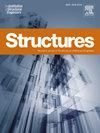Seismic loss risk and resilience assessment of air traffic control towers considering equipment functionality
IF 4.3
2区 工程技术
Q1 ENGINEERING, CIVIL
引用次数: 0
Abstract
Seismic loss risk assessments and evaluations of the seismic resilience of tower systems are critical for predicting operational safety at airports during seismic events. A multidimensional fragility model was developed utilizing the peak floor acceleration and the peak interstory displacement angle as seismic demand parameters, with the former indicating the impact on air traffic control (ATC) equipment. On the basis of this model and seismic hazard analysis, a seismic loss risk assessment method was proposed for the tower system, encompassing both the tower structure and ATC equipment. Furthermore, a seismic resilience assessment framework was established using loss and recovery functions to examine the functional degradation and restoration timelines for airport towers. The investigation revealed that the probability of failure for the tower system under near-field earthquakes was significantly greater than that under far-field earthquakes, for example, 38.0 % versus 93.0 % in the immediate occupancy (IO) limit state. When comparing the fragility results based on single versus dual seismic demand parameters, the multidimensional model yields more conservative predictions. For far-field earthquakes in the normal operation (NO) limit state, the fragility curves have failure probabilities of 66.4 %, 24.6 %, and 85.4 % for a single displacement angle, a single floor acceleration, and multidimensional models, respectively. The indirect economic losses of the tower system are significantly higher than the direct losses. Under near-field earthquake conditions at the DS3 limit state with a 9-degree seismic fortification, the maximum direct economic loss is 1168800 yuan, while the maximum indirect economic loss reaches 6428600 yuan. The functional losses of the tower system and ATC equipment during rare near-field earthquakes under 8 degrees of seismic fortification are 48 % and 10 %, respectively, with corresponding recovery times of 153.6 and 20.36 days.
考虑设备功能的空中交通管制塔地震损失风险及恢复力评估
地震损失风险评估和塔架系统的地震恢复力评估对于预测地震事件期间机场的运行安全至关重要。以峰值层加速度和峰值层间位移角为地震需求参数,建立了多维易损性模型,其中峰值层间位移角表示对空中交通管制设备的影响。在此模型的基础上,结合地震危害分析,提出了一种包括塔架结构和空管设备在内的塔架系统地震损失风险评估方法。此外,利用损失和恢复函数建立了一个地震弹性评估框架,以检查机场塔楼的功能退化和恢复时间。调查结果表明,近场地震作用下塔系的失效概率显著大于远场地震作用下的失效概率,如直接占用(IO)极限状态下的失效概率为38.0 %,远场地震作用下的失效概率为93.0 %。当比较基于单一和双重地震需求参数的易损性结果时,多维模型的预测结果更为保守。对于正常运行极限状态下的远场地震,单位移角、单层加速度和多维模型的脆性曲线破坏概率分别为66.4 %、24.6 %和85.4 %。塔系的间接经济损失明显高于直接经济损失。在DS3极限状态、9度抗震设防的近场地震条件下,最大直接经济损失为116.88万元,最大间接经济损失为6428.6万元。在8度设防的罕见近场地震中,塔架系统和ATC设备的功能损失分别为48 %和10 %,恢复时间分别为153.6和20.36天。
本文章由计算机程序翻译,如有差异,请以英文原文为准。
求助全文
约1分钟内获得全文
求助全文
来源期刊

Structures
Engineering-Architecture
CiteScore
5.70
自引率
17.10%
发文量
1187
期刊介绍:
Structures aims to publish internationally-leading research across the full breadth of structural engineering. Papers for Structures are particularly welcome in which high-quality research will benefit from wide readership of academics and practitioners such that not only high citation rates but also tangible industrial-related pathways to impact are achieved.
 求助内容:
求助内容: 应助结果提醒方式:
应助结果提醒方式:


